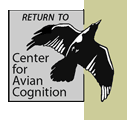 The kea, a crow-sized parrot from the rugged mountains of New Zealand, is considered
by some a playful comic and by others a menace to property and a killer of livestock.
Its true character has been debated by biologists for more than a century. Through
the University of California Press, Judy Diamond and Alan Bond have published the
first comprehensive account of the kea's contradictory nature. Their conclusions cast
new light on the origins of behavioral flexibility and the problem of species survival
in human environments everywhere.
The kea, a crow-sized parrot from the rugged mountains of New Zealand, is considered
by some a playful comic and by others a menace to property and a killer of livestock.
Its true character has been debated by biologists for more than a century. Through
the University of California Press, Judy Diamond and Alan Bond have published the
first comprehensive account of the kea's contradictory nature. Their conclusions cast
new light on the origins of behavioral flexibility and the problem of species survival
in human environments everywhere.
|
New Zealand's geographical isolation has made the country home to a remarkable assemblage
of plants and animals that are wholly unlike anything found elsewhere. Keas are native only
to the South Island, breeding high in the unforgiving environment of the Southern Alps.
Bold, curious, and ingeniously destructive, keas have a complex social system that
includes extensive play behavior and persisting associations between young birds. Like
coyotes, ravens, and humans, keas are "open-program" animals with a predisposition
to exploring novel situations and an unusual ability to develop new solutions to whatever
problems they encounter.
Diamond and Bond present the kea's story from historical and contemporary perspectives
and include observations and analyses from their years of field work. A comparison of the
kea's behavior and ecology with that of its closest relative -- the kaka of New Zealand's
lowland rain forests -- yields insights into the origins of the kea's extraordinary
adaptability. The authors conclude that the kea's high level of sociality is a central element
in their flexible lifestyle, one that may have evolved in response to the unreliable food
resources in their alpine habitat. Flexibility has allowed the birds to survive massive
changes in their original ecosystem. But adaptation has limits, as the authors make clear
when describing present-day interactions between keas and humans and attempts to achieve
a peaceful coexistence.
Since Bird of Paradox was published in 1999, experimental behavioral work on keas,
in both the lab and the field, has greatly expanded. Keas are now one of the most commonly
studied large parrots, especially with regard to physical cognition, problem solving, and
social learning. Their popularity has, coincidentally, made this monograph something of a
classic in its genre. As of 2016, it had been cited in nearly 100 peer-reviewed publications
in a burgeoning kea literature.


|




 The kea, a crow-sized parrot from the rugged mountains of New Zealand, is considered
by some a playful comic and by others a menace to property and a killer of livestock.
Its true character has been debated by biologists for more than a century. Through
the University of California Press, Judy Diamond and Alan Bond have published the
first comprehensive account of the kea's contradictory nature. Their conclusions cast
new light on the origins of behavioral flexibility and the problem of species survival
in human environments everywhere.
The kea, a crow-sized parrot from the rugged mountains of New Zealand, is considered
by some a playful comic and by others a menace to property and a killer of livestock.
Its true character has been debated by biologists for more than a century. Through
the University of California Press, Judy Diamond and Alan Bond have published the
first comprehensive account of the kea's contradictory nature. Their conclusions cast
new light on the origins of behavioral flexibility and the problem of species survival
in human environments everywhere.